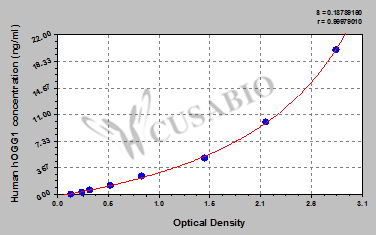| Code | CSB-E12686h |
| Size | 96T,5×96T,10×96T |
| Price | Request a Quote or Start an on-line Chat |
| Trial Size |
24T ELISA Kit Trial Size (Only USD$150/ kit) * The sample kit cost can be deducted from your subsequent orders of 96T full size kits of the same analyte at 1/5 per kit, until depleted in 6 months. Apply now |
| Intra-assay Precision (Precision within an assay): CV%<8% | ||||||
| Three samples of known concentration were tested twenty times on one plate to assess. | ||||||
| Inter-assay Precision (Precision between assays): CV%<10% | ||||||
| Three samples of known concentration were tested in twenty assays to assess. | ||||||
| To assess the linearity of the assay, samples were spiked with high concentrations of human hOGG1 in various matrices and diluted with the Sample Diluent to produce samples with values within the dynamic range of the assay. | ||||||
| Sample | Serum(n=4) | |||||
| 1:1 | Average % | 103 | ||||
| Range % | 98-112 | |||||
| 1:2 | Average % | 84 | ||||
| Range % | 80-88 | |||||
| 1:4 | Average % | 92 | ||||
| Range % | 88-96 | |||||
| 1:8 | Average % | 90 | ||||
| Range % | 85-94 | |||||
| The recovery of human hOGG1 spiked to levels throughout the range of the assay in various matrices was evaluated. Samples were diluted prior to assay as directed in the Sample Preparation section. | ||||||
| Sample Type | Average % Recovery | Range | ||||
| Serum (n=5) | 97 | 92-101 | ||||
| These standard curves are provided for demonstration only. A standard curve should be generated for each set of samples assayed. | |||||||||||||||||||||||||||||||||||||||||||||||||||||||||||||||

| |||||||||||||||||||||||||||||||||||||||||||||||||||||||||||||||
The Human 8-oxoguanine DNA glycosydase (hOGG1) ELISA kit is designed to enable accurate and reliable detection of 8-oxoguanine DNA glycosydase in Homo sapiens (Human) samples.
This ELISA kit offers a versatile solution for researchers studying cancer、DNA repair, allowing for the detection of hOGG1 in serum, tissue homogenates, and cell lysates. With a wide detection range of 0.312 ng/mL-20 ng/mL and a sensitivity of 0.078 ng/mL, this kit provides accurate and sensitive measurements of hOGG1 levels in samples.
The assay time for this ELISA kit is 1-5 hours, and sample volume ranges from 50-100ul. The detection wavelength is 450 nm, and the measurement method is sandwich, providing a quantitative approach for researchers studying the role of hOGG1 in cancer and DNA repair
There are currently no reviews for this product.